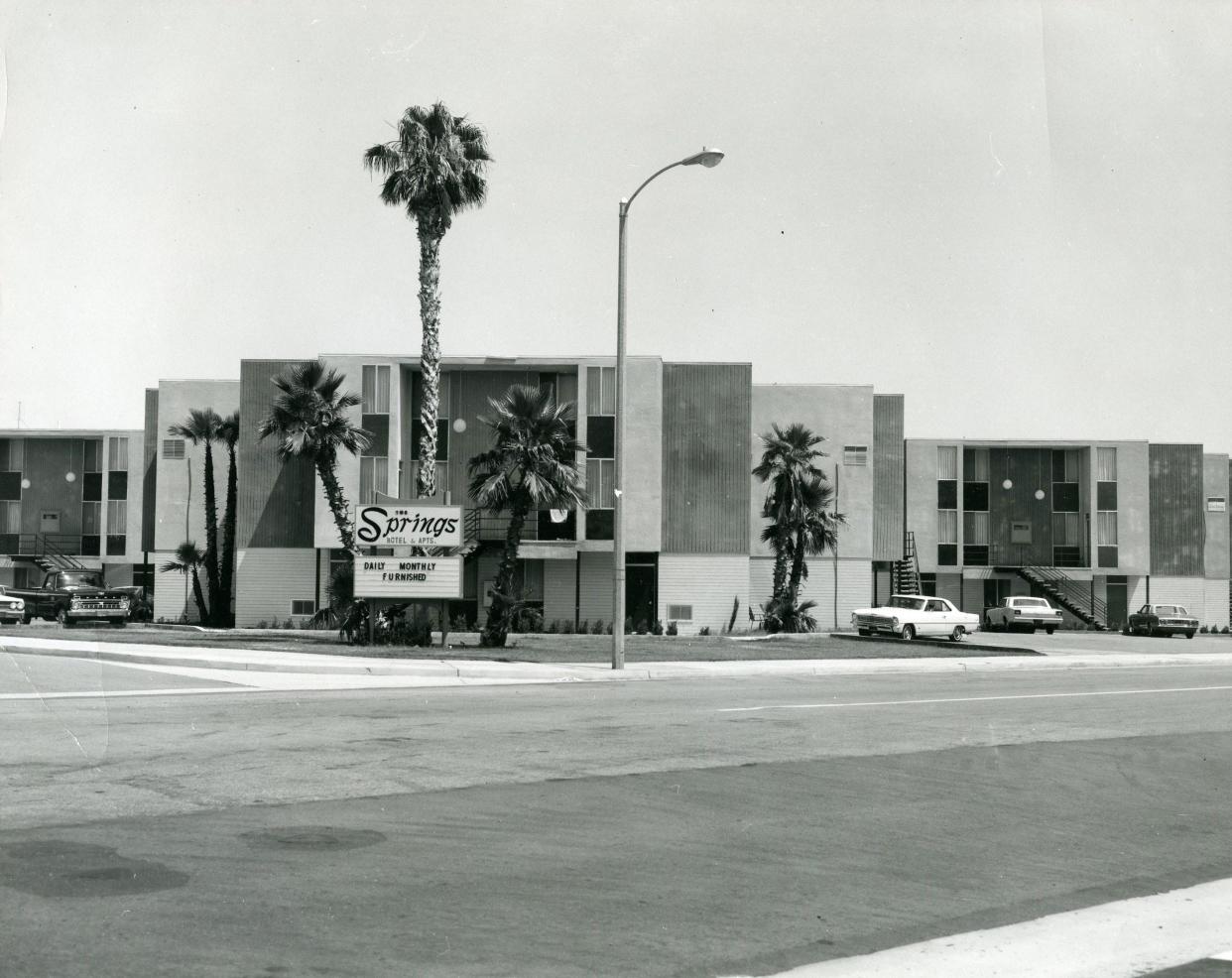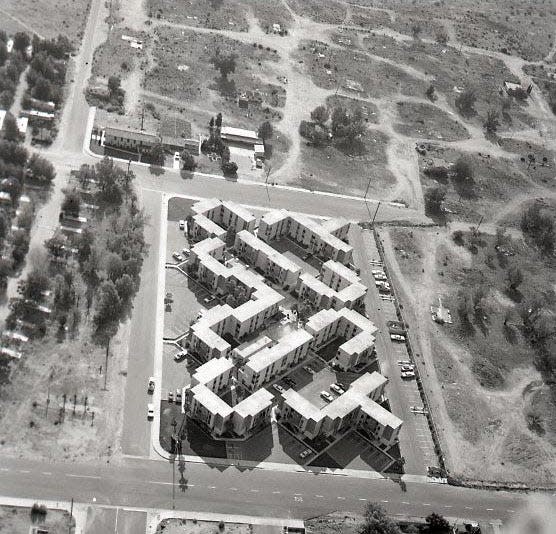Palm Springs history: City has long struggled to provide affordable housing for workers

- Oops!Something went wrong.Please try again later.
The newspaper advertisement headline read, “Now Open, New!!” The Seminole Garden apartments in Palm Springs were definitely a novel development for the desert. The project featured two- and three-bedroom apartments, in a “park-like” setting, “beautifully landscaped.” Gas, water and trash removal were included “from a $107 per month” and were intended for couples and “families of moderate income,” regular working people. Immediate occupancy was available as soon as the project opened in May 1969.
The newspaper noted, “The first medium-income housing complex developed in a major resort city under a certain FHA program has opened its doors in Palm Springs …The project is under the government’s FHA program, where by a sponsor is limited to a maximum six per cent return on his investment, allowing for economical rental rates. Rentals and family income maximum limits are regulated by the Federal Housing Authority. At present, family qualifying income ceilings are set to provide that the rent does not exceed 20 percent of the family’s income.”
“The first tenant to move into the apartment complex was Mrs. Shendell Cast, who came to the desert with her son, David, 6, from Sherman Oaks about two weeks ago. She is employed at the Von’s on Sunrise Way.”
Originally named for the major street leading to the complex, Seminole Gardens began construction in August 1968 on the 10-acre site bordered by Seminole Drive and Cherokee Way (though the address was actually Linden Way).
The project was comprised of 30 two-bedroom and 30 three-bedroom units situated in five two-story buildings surrounded by gardens, and offering laundry, a playground and a large, heated pool.
No one seemed particularly surprised when a mere 9 months later, Seminole Gardens was finished and ready for tenants.
“Owner and sponsor of the complex is Joseph F. Sanson Investment Co. of Las Vegas which contracted the Baron Construction Co. of the same city to do the work. The complex includes 30 units each of two and three bedrooms. The two-bedroom units rent for $107 a month and are limited to families of not more than four persons. The three-bedroom apartments, limited to families of not more than six persons, rent for $127 to $131 a month.”
The successful completion of Seminole Gardens was an important milestone for Palm Springs. The city had previously tried to create a housing development for working folks on an even grander scale.

In August 1961, the paper featured a huge banner headline in all capital letters: “$2.5 MILLION APARTMENT PROJECT SLATED FOR SECTION 14 FAMILIES” and had a subhead that read “Wolf-Newman To Construct 8-Acre Project.”
It was astounding news. The “development which will be used for families displaced from Section 14 has been given approval by the Federal Housing Administration, subject to certain government specifications, and will soon be under construction within even a few feet of Palm Springs City Limits. Eight acres of land has been purchased by the N&W Development Corp. as the site of the multi-million dollar project and as the green light was given from Washington, the developers were already completing their plans for the apartments.”
“This will not only be the first medium-cost relocation housing project, but … will be the first project of its kind in the desert area (and) will have a bomb shelter built for each unit.”
Escrow for purchase of land began on July 5 and was closed less than 30 days later. “While escrow was working Wolf and Newman made their application to the FHA … for the moderate cost housing project and just three weeks ago made a rush trip to Washington to set their application through the proper channels. Because of the ‘emergency’ which faces Section 14 residents today, the FHA processed the papers and called the developers to tell them their application had been approved.”
The Desert Sun reported on Aug. 18, 1961, “Late yesterday afternoon Wolf and Newman called Mayor Frank Bogert to meet with them in a conference at the Biltmore Hotel. The mayor, working tirelessly for a low cost housing project, had asked Wolf some months ago if he couldn’t come up with a solution to the ever increasing problem of homes for the scores of people who are residing on Section 14, who are presently on notice that they must move from their present homes to make way for a full scale Indian Section clearance program.”
“With the FHA approval and the promise of the granting of a loan, N&W Development Corp. within the next few weeks will start actual construction of 150 to 200 one-, two- and three-bedroom apartment homes. The development will have two swimming pools, recreation rooms, and the entire grounds throughout the development will be beautifully landscaped.”
“On hearing about the plans for the project Mayor Bogert was elated. It had brought to an end the months upon months of studying for a solution (for the problem) which was only worsening with time.”
“Residents of the southwest quarter of Section 14 have fought relentlessly to save their homes because ‘we have nowhere else to go.’ The Indian landowners of Section 14 have served notice on their tenants that they must vacate the land. The court and Indian conservators have worked to clear the ever more valuable mid-downtown slum section.”
But the gigantic project and the much-sought housing for working people was not to be. It wasn’t until seven years later in November 1968 that the city had a project actually under construction, the more modest Seminole Gardens.
The newspaper looked back at the failed previous attempt “the blockbuster news announced on August 18, 1961 by local contractor Leonard Wolf, Jr. and financier Herman C. Newman and was the upshot of a previous request, of several months standing, by Mayor Bogert of Wolf to seek a solution to the problem of homes for the residents of Section 14.”
Despite the speedy escrow and astonishingly quick approval by the FHA, the project sadly never came to fruition. The paper explained, “financier Newman subsequently succumbed, and that was followed by a period of ‘tight money’ when for several years, the entire country was enveloped in a recession which set back many major housing and building development projects everywhere. And the period was particularly harmful to the city’s plans for the immediate solution to the problems of Section 14.”
In August 1970, the paper reported, “City officials were jubilant today over news that Washington officials had approved a low-cost loan application by a Beverly Hills builder for construction of $1,150,000 apartment complex in Section 14 near the downtown area of Palm Springs. The structure will provide 76 units for families of medium to low incomes.”
Ironically, located on Section 14 on 2.5 acres of Indian-owned land bounded by Calle Encilia and El Segundo, south of Arenas road, the Springs apartments were developed by Stanley S. Leeds, who was also the recipient of assistance funds from the FHA. When it came to fruition, it was the second such apartment complex in Palm Springs.
Seminole Gardens was already fully occupied, and Planning Director Richard Smith said he understood there was “quite a waiting list.”
Tracy Conrad is president of the Palm Springs Historical Society. The Thanks for the Memories column appears Sundays in The Desert Sun. Write to her at pshstracy@gmail.com.
This article originally appeared on Palm Springs Desert Sun: Palm Springs history: City has long struggled to provide affordable housing for workers

